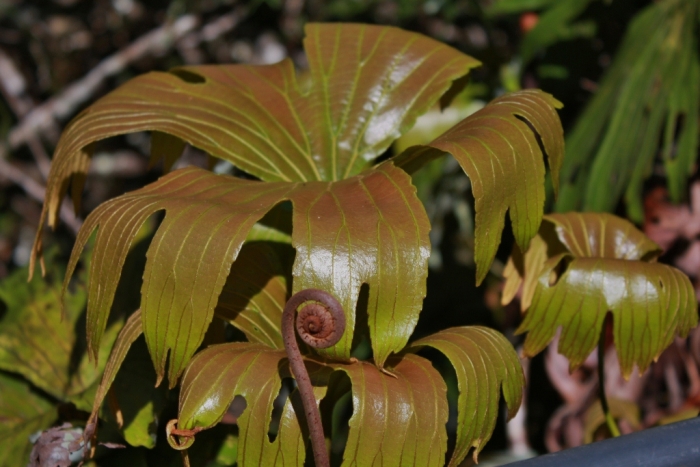Broad-Leaf Fern
(Dipteris conjugata)
Broad-Leaf Fern (Dipteris conjugata)
/
/

Thomas Brown
CC BY 2.0
Image By:
Thomas Brown
Recorded By:
Copyright:
CC BY 2.0
Copyright Notice:
Photo by: Thomas Brown | License Type: CC BY 2.0 | License URL: https://creativecommons.org/licenses/by/2.0 | Uploader: File Upload Bot (Magnus Manske) | Publisher: Wikimedia Commons | Title: Fern_(Dipteris_conjugata)_(7113325651).jpg | Notes: {{Information |Description={{en|''[[:en:Dodecatheon meadia|Dodecatheon meadia]]'', dry limestone barren Prairie|Lynx Prairie]], [[:en:Adams County, Ohio|Adams County, Ohio]].}} |Source={{own}} |Date=created 20 May 2011 |Author=Maso

































Estimated Native Range
Summary
Dipteris conjugata, commonly known as Broad-Leaf Fern, is a perennial herbaceous fern with a creeping rhizome covered in black shiny hairs or reddish-brown hairlike scales. It is native to tropical rainforests and moist, shaded areas in Southeast Asia and Australasia. The fern produces 2-3 tall stems with mid-green to dark green fronds that can reach up to 1 meter wide. These fronds are divided to the base into two spreading fan-shaped halves, further divided more than halfway into 4 or more unequal lobes, which are again less deeply lobed once or more times. The fronds are paler or glaucous underneath, with numerous small sori on the lower surface, which are irregularly scattered and of irregular size and shape, indicating its reproductive strategy.
The Broad-Leaf Fern is appreciated for its lush, tropical appearance and the architectural quality of its fronds, making it a popular choice for shaded garden areas, ferneries, and as an underplanting in subtropical and tropical landscapes. It is generally easy to maintain, mostly disease and pest resistant, and can adapt to a range of soil conditions from poor to well-drained. In cultivation, it thrives best in full sun to part shade, with medium amounts of water, and in soils with slow to medium drainage. While not commonly known for its flowers, as ferns do not produce flowers, its fronds are highly decorative and provide year-round interest.CC BY-SA 4.0
The Broad-Leaf Fern is appreciated for its lush, tropical appearance and the architectural quality of its fronds, making it a popular choice for shaded garden areas, ferneries, and as an underplanting in subtropical and tropical landscapes. It is generally easy to maintain, mostly disease and pest resistant, and can adapt to a range of soil conditions from poor to well-drained. In cultivation, it thrives best in full sun to part shade, with medium amounts of water, and in soils with slow to medium drainage. While not commonly known for its flowers, as ferns do not produce flowers, its fronds are highly decorative and provide year-round interest.CC BY-SA 4.0
Plant Description
- Plant Type: Fern
- Height: 6-10 feet
- Width: 4-10 feet
- Growth Rate: Moderate
- Flower Color: N/A
- Flowering Season: Non-Flowering
- Leaf Retention: Evergreen
Growth Requirements
- Sun: Full Sun, Part Shade
- Water: Medium
- Drainage: Slow, Medium
Common Uses
Deer Resistant, Low Maintenance
Natural Habitat
Tropical rainforests and moist, shaded areas in Southeast Asia and Australasia
Other Names
Common Names: Bua Chaek, 雙扇蕨, Bua Cek
Scientific Names: , Dipteris conjugata, Dipteris horsfieldii, Polypodium dipteris, Polypodium horsfieldii, Drynaria horsfieldii, Phymatodes conjugata,
GBIF Accepted Name: Dipteris conjugata Reinw.